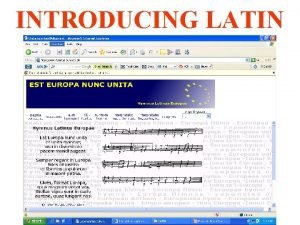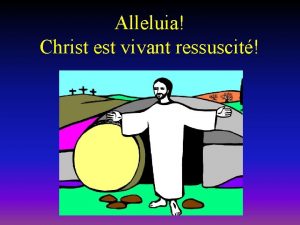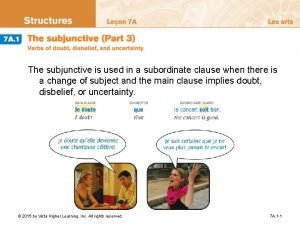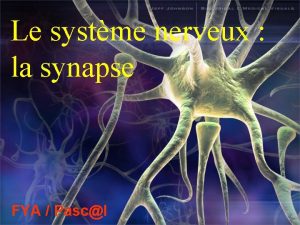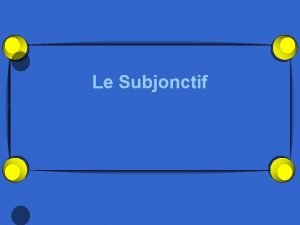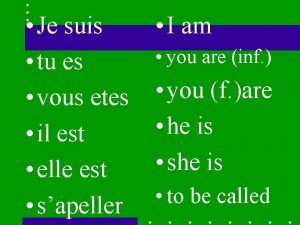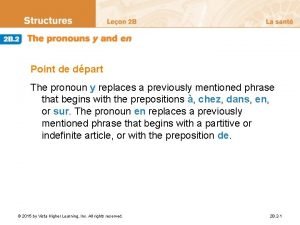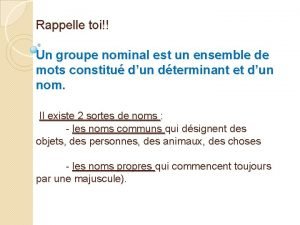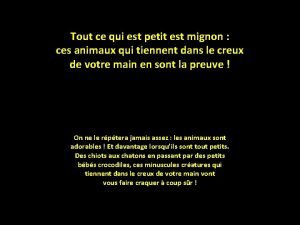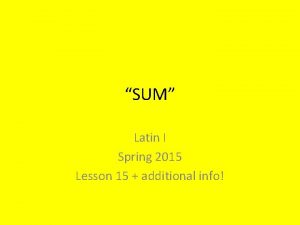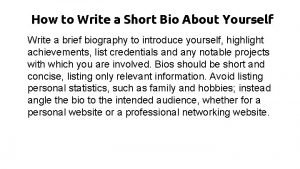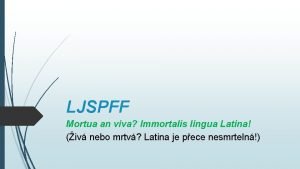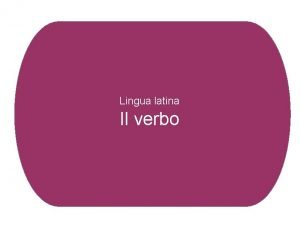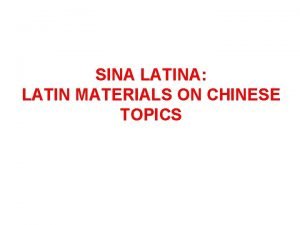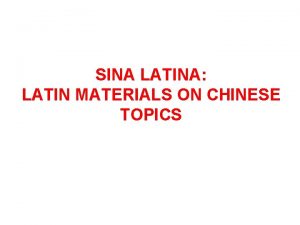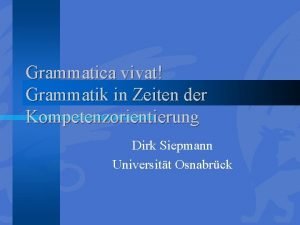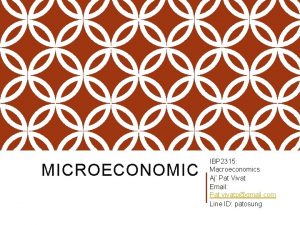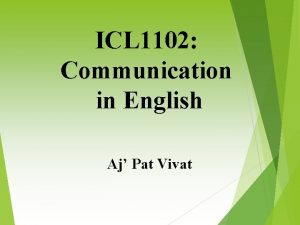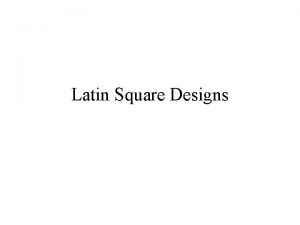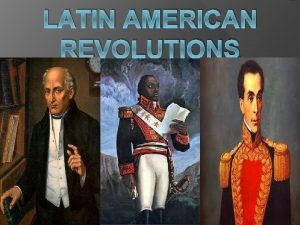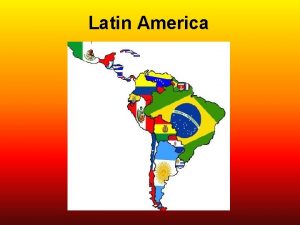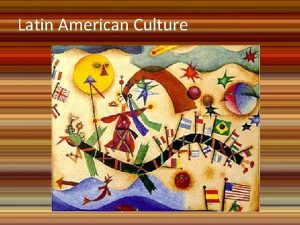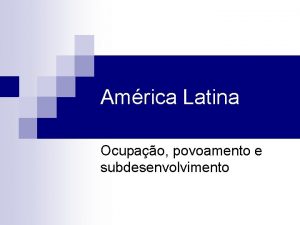INTRODUCING LATIN Lingua Latina mortua est vivat lingua


































- Slides: 34

INTRODUCING LATIN

Lingua Latina mortua est, vivat lingua Latina! Salvete, domini dominaeque. Benigne vos excipimus, qui transmittamus relationem temporis culturae televisificam singularem - totam Latine versam, quod non dubie iam intellexistis. De mortuis nihil nisi bene. Estne Latinitas re vera mortua? Audeamus et experiamur proferre communem relationem televisificam Latine versam. Lingua Latina ibi inveniri potest, ubi nemo hanc esse suspicetur. Exempli gratia medio in ventre Angelinae Jolie notis Latinis compunctum est: "Quod me nutrit, me destruit. " Quae res ratione carere videtur, sed haeret in mente, quod spectaculis maximi momenti est. (opening lines of the special Latin edition of the arts magazine programme `Kulturzeit’, broadcast by the German channel Sat 3 in August 2008 http: //www. 3 sat. de/mediathek. php? obj=9250&mode=play )

Lingua Latīnā unde vēnit? Where did Latin come from?









DIFFERENTIA PRINCIPĀLIS INTER IMPERIUM SĪNICUM ET IMPERIUM RŌMĀNUM • SĪNA: 天下大勢, 分久必合, 合久必分 – After the original creation of a unified China, the Chinese cultural area did not always remain united but political unity was seen as a state to which it would eventually return • EURŌPA: 天下大勢, 合久必分, 分久不合 – After a brief revival at the end of the 8 th century, the political unity imposed on much of Europe by Rome was seen as permanently lost: `No political unifier after Charlemagne, no Bonaparte or Hitler, ever succeeded, partly because he was not expected to’ (John Fairbank, The Great Chinese Revolution, p. 11)

After the end of the Roman th Empire (5 cent. A. D. ) • Latin remains the main spoken language in most of western Europe but slowly splits up to become Portuguese, Spanish, French, Italian and Romanian. • Until about 1100 A. D. , people continue writing in Latin but pronounce in their local way – just as written Chinese can be read aloud in Putonghua or Cantonese pronunciation • After 1100, ordinary documents are often written in the local language but Latin is still used for many government records (even in countries in northern and eastern Europe that were never part of the Roman Empire), for scholarly writing, for international communication and as the official language of the Catholic Church.

th 16 – th 20 centuries • The main modern languages slowly replace Latin in record keeping and scholarly writing. French replaces Latin as the European link language – Isaac Newton’s Principia Mathematica (1687) is in Latin but his Optica (1704) in English – First international treaty in French is signed in 1714, last in Latin in 1756 • Latin remains the official language of the Catholic Church until the 1960 s • Latin remains an important school subject until the 1960 s • Many Latin words are still borrowed into modern European languages

Examples of English words borrowed from Latin, either directly or via French THE DECLARATION OF INDEPENDENCE In Congress, June 4, 1776 The unanimous declaration of the thirteen United States of America. When in the course of human events, it becomes necessary for one people to dissolve the political bands which have connected them with another, and to assume among the powers of the earth, the separate and equal station to which the Laws of Nature and of Nature's God entitle them, a decent respect to the opinions of mankind requires that they should declare the causes which impel them to the separation.

The introduction to the Declaration re-written using only native English words and syllables (from http: //anglish. wikia. com/wiki/Saying_Forth_of_Self_Rule) THE SAYING FORTH OF SELF RULE In Lawmaker Body, Afterlithe 4, 1776. The anmood saying forth of the thirteen Banded Folkdoms of Americksland, When in the flow of mannish happenings, it becomes needful for one folk to break up the mootish bands which have bonded them with another, and to take among the mights of the earth, the freestanding and even post to which the laws of life and of life’s God give them, a good worth to the thoughts of mankind must needs that they should say forth the grounds which bring them to the sundering.

Circumspice, linguam Latīnam vidēbis! Latin around you

`NISI DOMINUS FRUSTRA’

The Latin words `NISI DOMINUS FRUSTRA’ are written at the bottom of the inscription commemorating the completion of the Shing Mun dam and reservoir in 1936

PSALM XXXVI. 1 詩 • nisi Dominus aedificaverit domum. in unless Lord will-have-built vanum laboraverunt qui vain house in aedificant eam will-have-worked those-who build it • nisi Dominus custodierit civitatem frustra unless Lord vigilat qui will-have-guarded city custodit eam watches he-who guards it in-vain

Do you recognise this?

HOGWARTS SCHOOL MOTTO DRACO DORMIENS NUNQUAM DRAGON SLEEPING NEVER TITILLANDUS NEEDING-TO-BE-TICKLED A sleeping dragon should never be tickled

EXPECTO PATRONUM!

EXPECTO PATRONUM I-wait-for patron I am waiting for my patron (the magical protector that comes out from the end of a wizard’s wand)

Everyday Latin • etc. = et cetera (and other-things) • e. g. = exempli gratia (for example) • status quo (state in-which [things are]) – the present system, the way society and politics are now • A. D. = Anno Domino (in-the-year of-the-Lord) • data (things-given) – the information that is available to you • agenda (things-needing-to-be-done) – list of business to be discussed in a meeting

How Latin works: `Aspice caudam!’ (Look at the tail!)

DOG BITES MAN

MAN BITES DOG

CANIS HOMINEM MORDET

HOMO CANEM MORDET

The endings of words usually show their connection to each other so word order is flexible • Homo canem mordet (NORMAL ORDER) – The man bites the dog • Canem homo mordet – The man bites the dog • Mordet homo canem – The man bites the dog

As well as drawing special attention to particular words, changes from normal word order make it easier to fit words into the rhythm of a poem. In the last two lines of the unofficial European anthem, the –ae ending on the adjective aureae (`golden’) shows that it describes stellae (`stars’) and not signa (`signs’) or caelo (`sky’) Stellae signa sunt in caelo aureae, quae iungant nos The golden stars are signs in the sky, which may unite us

Can you work out the meaning of –mus and of –ba- in these verb forms? • • surgimus amabant sedemus veniebam regebatis viceramus we get up they were loving we sit we come I was coming you were ruling we had won

ACKNOWLEDGEMENTS • © Peter Roland Peter Diem for the European anthem • © Bible History Online (http: //www. biblehistory. com) for map of ancient Italy • © Interactive Media Lab, College of Journalism and Communications, University of Florida for pictorial map of the Roman Empire • © http: //resourcesforhistory. com/map. html for animated map of Roman Empire
 Lingua latina mortua est
Lingua latina mortua est Nulla est medicina sine lingua latina
Nulla est medicina sine lingua latina Nulla est medicina sine lingua latina
Nulla est medicina sine lingua latina Invia est in medicina via sine lingua latina
Invia est in medicina via sine lingua latina Chant alleluia christ est vivant
Chant alleluia christ est vivant Verbe detat
Verbe detat Seul le silence est grand tout le reste est faiblesse
Seul le silence est grand tout le reste est faiblesse Il est douteux que le metteur en scène où est l’acteur.
Il est douteux que le metteur en scène où est l’acteur. Qu'est ce que c'est
Qu'est ce que c'est Je suis tu es nous sommes vous etes
Je suis tu es nous sommes vous etes Subjonctif
Subjonctif Mon dieu tu es grand tu es bon parole
Mon dieu tu es grand tu es bon parole Quel est le nom de la femelle du sanglier
Quel est le nom de la femelle du sanglier Appuyez sur l’image qui est dans le bon sens
Appuyez sur l’image qui est dans le bon sens Qu'est ce que c'est
Qu'est ce que c'est Je suis tu es il est nous sommes vous etes ils sont
Je suis tu es il est nous sommes vous etes ils sont Tu es grand tu es beau
Tu es grand tu es beau Faites-vous du sport? oui, nous 1 of 1 faisons.
Faites-vous du sport? oui, nous 1 of 1 faisons. Les groupes nominaux
Les groupes nominaux Total float= * 1 point lst-est lst-eft est-lft eft-lst
Total float= * 1 point lst-est lst-eft est-lft eft-lst Tout ce qui est petit et mignon
Tout ce qui est petit et mignon Kochelsee
Kochelsee Latin root sum
Latin root sum Introducing a counterclaim
Introducing a counterclaim Ma
Ma Introducing quotes
Introducing quotes The purpose of introducing weakened microbes
The purpose of introducing weakened microbes Formal greeting dialogue
Formal greeting dialogue Biographical statement about yourself
Biographical statement about yourself Integers essential questions
Integers essential questions Answer key
Answer key Templates for introducing quotations
Templates for introducing quotations Safe relentless improvement
Safe relentless improvement They say i say moves that matter in academic writing
They say i say moves that matter in academic writing Unit 1 about myself
Unit 1 about myself
